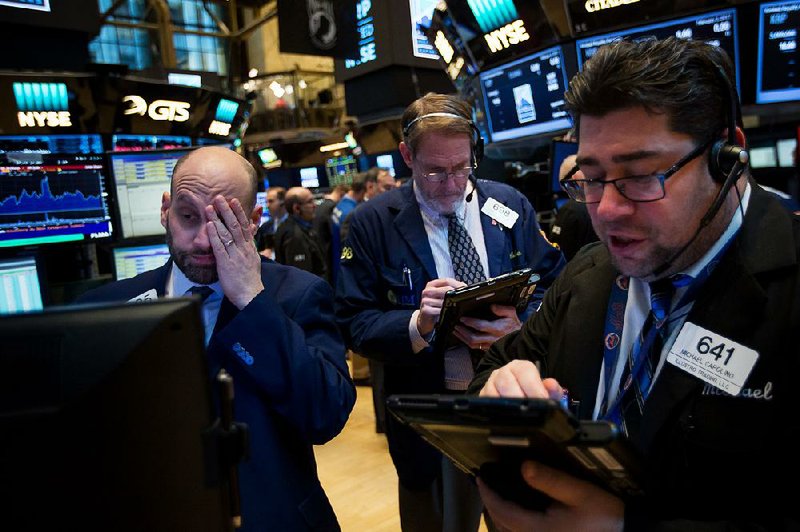WASHINGTON -- U.S. employers stepped up hiring last month, adding a healthy 227,000 jobs, and more Americans began looking for work.
January's job growth was the best since September, and it exceeded last year's average monthly gain of 187,000, the Labor Department said Friday.
"The labor market started 2017 on the front foot," said Carl Tannenbaum, chief economist at Northern Trust. "This is a good, good number."
The unemployment rate ticked up to a still-low 4.8 percent from 4.7 percent in December. But the rate rose for an encouraging reason: More Americans started looking for work, though not all of them found jobs immediately. The proportion of adults who are either working or looking for work reached its highest point since September.
Friday's report depicted an American job market that is generating consistently solid hiring and encouraging more people to start looking for work. Nearly a half-million people who weren't previously job-hunting began doing so in January.
If employers keep hiring, even more Americans could be drawn into the job market.
"The increase in the unemployment rate came about from both more people working and more people looking for work -- a positive," said Gus Faucher, an economist at PNC.
Yet some of the economy's softness remains: Average hourly wages -- a weak spot since the recession ended 7½ years ago -- barely rose last month. And the number of people working part time who would prefer full-time work rose.
"There's still a very strong resistance from firms to pay higher wages," said Scott Brown, St. Petersburg, Fla.-based chief economist for Raymond James Financial Inc. "There's a gradual uptrend. You're not seeing really rapid wage growth, but it's sort of gradually creeping higher."
Investors appeared upbeat about the jobs report. The Dow Jones industrial average rose 186.55 points, or 0.9 percent, to 20,071.46.
January's jobs figures reflect hiring that occurred mainly before President Donald Trump was inaugurated on Jan. 20. Still, it was the first employment report to be released with Trump occupying the White House.
Trump expressed his satisfaction with the jobs report in brief remarks Friday. And he suggested that the sharp hiring gain in January reflected improved confidence among employers about his administration.
"Great spirit in the country right now," Trump said as he began a meeting at the White House with leading corporate CEOs and other business leaders. "We're very happy about that.
"We're bringing back jobs, we're bringing down your taxes, we're getting rid of your regulations."
As a candidate, Trump had frequently argued that the government's jobs data exaggerated the health of the economy. He called the unemployment rate a "hoax" and said it declined after the recession under President Barack Obama mainly because many Americans stopped working or looking for work.
The biggest factor in that trend has been widespread retirements by the vast generation of baby boomers. But in addition, many Americans of working age, particularly men with a high school diploma, have also stopped looking for work.
January's solid job gain coincides with other data suggesting that the economy might be picking up after a sluggish 2016. Consumers are more confident and spending more, manufacturers are producing more goods and home sales stand at mostly healthy levels.
The rise in part-time work lifted an alternative gauge of unemployment -- one that also includes involuntary part-time workers and people no longer looking for work -- from 9.2 percent to 9.4 percent.
Last month's hiring ranged across most industries, and in some cases the gains might have reflected weather and other seasonal quirks. Construction companies, for example, added 36,000 jobs, the most since March. That figure might have been boosted by unseasonably warm weather in the Northeast.
Manufacturing added 5,000 jobs, its second straight gain after a string of losses in the fall.
Retailers generated 46,000 more jobs, the sharpest monthly gain in nearly a year. But that increase likely reflected imperfections in the government's seasonal adjustment process, which tries to filter out the hiring and subsequent layoff of temporary retail workers for Christmas. Excluding seasonal adjustments, retailers shed jobs last month, as they do nearly every January.
The proportion of Americans who were either working or looking for work in January rose to 62.9 percent from 62.7 percent in December. Before the recession began in 2007, that figure had been 66 percent.
Employers across sectors and across the nation have increasingly complained about the difficulty of finding workers, a competition that has kept wage growth somewhat ahead of a 1.6 percent inflation rate.
"We're still continuing to see wage pressure as the candidate market continues to shrink," said Amy Glaser, senior vice president of Adecco Staffing USA, which has 300 branch offices.
In addition to the omnipresent hunger for engineers, Glaser said there is a demand for those with middle-level trade skills such as welding that fell into disuse during the recession, as well as entry-level warehouse and light-assembly workers.
"Employers are getting very creative," said Glaser, whose office is in Lexington, Ky. "We're seeing sign-on bonuses. They have added sabbaticals to their packages, increases to stock options, free child care on site and free meals. Anything to get a competitive edge."
"I'm definitely seeing a trend of employers targeting certain pools of workers like the disabled, retirees that may be looking to return to the workforce and stay-at-home moms," she added.
Information for this article was contributed by Christopher S. Rugaber of The Associated Press, Patricia Cohen of The New York Times and Patricia Laya of Bloomberg News.
Business on 02/04/2017
